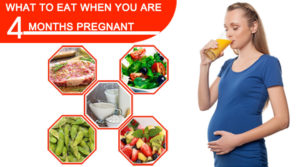Congratulations on reaching your fourth month of pregnancy! This exciting time brings a wave of changes, from increased energy levels to a growing baby bump. But along with this newfound energy comes a crucial need for iron.
Iron is a superhero nutrient for both you and your developing baby. It helps create red blood cells, which carry oxygen throughout your body and to your baby. During pregnancy, your blood volume increases significantly, and your baby starts drawing iron from your stores to build their own red blood cells. This is why ensuring a sufficient iron intake becomes especially important in the fourth month.
Here’s what you need to know about iron during your fourth month of pregnancy, along with delicious and practical ways to incorporate iron-rich foods into your diet!

The Importance of Iron Reach Foods During the 4 Months of Pregnancy
Iron deficiency is a common concern during pregnancy, affecting nearly half of all pregnant women. This deficiency can lead to anemia, which causes fatigue, and shortness of breath, and even affects your baby’s development.
The recommended daily intake of iron for pregnant women jumps from 18 milligrams (mg) in the first trimester to 27 mg in the second and third trimesters. So, during this crucial fourth month, upping your iron intake is essential.
Here’s a breakdown of why iron is vital in the fourth month:
- Rapid Baby Growth: Your baby’s organs and systems are rapidly developing in the fourth month. This rapid growth requires a good supply of oxygen, which iron helps transport through your bloodstream.
- Increased Blood Volume: Your own blood volume increases by up to 50% during pregnancy [3]. This extra blood needs sufficient iron to carry oxygen effectively.
- Placenta Development: The placenta, which nourishes your baby, also requires iron for proper function.
By ensuring adequate iron intake, you’re setting yourself and your baby up for a healthy and energetic pregnancy.
Signs You Might Need More Iron
While some women may not experience any symptoms, here are some signs that you might be iron deficient:
- Extreme fatigue
- Pale skin
- Shortness of breath
- Dizziness
- Heart palpitations
- Cold hands and feet
- Restless legs syndrome
If you experience any of these symptoms, talk to your doctor. They can do a simple blood test to check your iron levels and recommend the best course of action, which might include dietary changes or iron supplements.
Power Up Your Plate: Iron-Rich Food Options
Now for the fun part – incorporating delicious and iron-rich foods into your diet! Here’s a breakdown of some fantastic options:
1. Heme Iron
This type of iron is more readily absorbed by your body and is found primarily in animal sources.
- Lean Red Meat: Beef, lamb, and pork are excellent sources of heme iron. However, moderation is key. Opt for lean cuts and avoid processed meats like sausages and hot dogs.
- Poultry: Chicken and turkey are good options, especially dark meat which has a higher iron content.
- Fish and Shellfish: Salmon, tuna, oysters, and clams are packed with iron and offer a welcome change from land-based protein sources.
2. Non-Heme Iron
This type of iron is found in plant-based foods and is slightly less absorbed by the body. However, by pairing these foods with vitamin C-rich sources, you can significantly improve iron absorption.
- Leafy Green Vegetables: Load up on spinach, kale, Swiss chard, and collard greens. These superstars are not only rich in iron but also provide essential vitamins and fiber.
- Beans and Lentils: Black beans, kidney beans, chickpeas, and lentils are powerhouses of iron, protein, and fiber. Enjoy them in soups, salads, or as a hearty main course.
- Dried Fruits: Raisins, prunes, apricots, and dates are a delicious and portable source of iron. Plus, they offer a natural sweetness to satisfy your cravings.
- Fortified Foods: Many breakfast cereals, breads, and pastas are fortified with iron. Check the labels to make sure you’re getting a good amount per serving.
3. Vitamin C Power Boost
Don’t forget the vitamin C factor! Vitamin C helps your body absorb non-heme iron more efficiently. Here are some vitamin C-rich foods to pair with your iron-rich meals:
- Citrus fruits (oranges, grapefruits, lemons)
- Bell peppers
- Broccoli
- Tomatoes
- Strawberries
Creative and Delicious Iron-Rich Foods:
- Breakfast Scramble: Whip up a veggie-packed scramble with spinach, mushrooms, and peppers. Add some crumbled feta cheese for extra protein and calcium.
- Lentil Soup with a Citrus Kick (continued): A squeeze of lemon or orange juice at the end will boost iron absorption.
- Quinoa Power Bowl: This versatile grain is a complete protein source and rich in iron. Top it with roasted vegetables, black beans, and a dollop of guacamole for a satisfying lunch or dinner.
- Black Bean Burgers: These vegetarian patties are a fun and flavorful way to get your iron fix. Serve them on whole wheat buns with all the fixings for a satisfying meal.
- Salmon with Roasted Sweet Potatoes and Broccoli: Salmon is a great source of heme iron and omega-3 fatty acids, while sweet potatoes and broccoli are loaded with vitamin C. This combination is a nutritional powerhouse.
- Iron-Fortified Oatmeal with Berries and Nuts: A warm bowl of oatmeal is a comforting and nutritious breakfast option. Choose iron-fortified oats and top with fresh berries, nuts, and a drizzle of honey for extra flavor and iron absorption.
Snack Time Superstars:
Don’t forget about healthy snacks! Here are some iron-rich options to keep you energized throughout the day:
- Hard-boiled eggs – A classic and convenient protein and iron source.
- Edamame – These steamed soybeans are packed with plant-based protein and iron.
- Trail mix – Make your own trail mix with nuts, seeds, and dried fruits for a satisfying and iron-rich snack.
- Yogurt with berries and pumpkin seeds – Yogurt provides protein and calcium, while berries offer vitamin C and pumpkin seeds are a good source of iron.
Important Tips for Maximizing Iron Absorption:
- Space Out Your Coffee and Tea: While you might enjoy your morning cup of coffee or tea, these beverages can hinder iron absorption. Avoid consuming them right before or after meals rich in iron.
- Limit Calcium-Rich Foods During Meals: Calcium from dairy products can also interfere with iron absorption. Space out your iron-rich meals from dairy consumption by a few hours.
- Cook in Cast Iron Skillets: Believe it or not, cooking in cast iron cookware can actually add a small amount of iron to your food.
Remember:
- Talk to your doctor: It’s important to discuss your iron needs with your doctor. They can monitor your iron levels and recommend the best course of action, including iron supplements if needed.
- Listen to your body: Pay attention to your energy levels and any symptoms you might be experiencing. If you feel excessively fatigued or have other concerns, consult your doctor.
- Variety is key: Don’t limit yourself to just a few iron-rich foods. Explore different options and create delicious and nutritious meals throughout your pregnancy.
Finishing Touch
By incorporating these tips and recipes, you can ensure you’re getting enough iron to support your health and your baby’s development during this exciting fourth month of pregnancy. Enjoy this energetic time and embrace the journey of motherhood!
